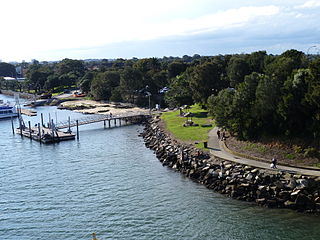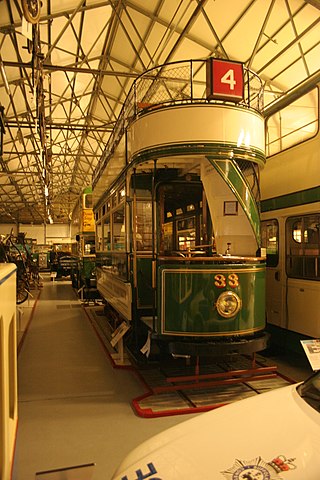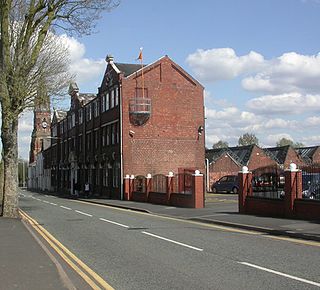
Sans Souci is a Southern Sydney suburb in the state of New South Wales, Australia. Sans Souci is 17 kilometres south of the Sydney central business district and lies across the local government areas of the Bayside Council and the Georges River Council. It is part of the St George area.

The Sydney tramway network served the inner suburbs of Sydney, Australia, from 1879 until 1961. In its heyday, it was the largest in Australia, the second largest in the Commonwealth of Nations, and one of the largest in the world. The network was heavily worked, with about 1,600 cars in service at any one time at its peak during the 1930s . Patronage peaked in 1945 at 405 million passenger journeys. Its maximum street trackage totalled 291 km in 1923.

The Kingston upon Hull tramway network was a network of 4 ft 8+1⁄2 instandard gauge tram lines following the five main roads radially out of the city centre of Kingston upon Hull, East Riding of Yorkshire, England. Two of these lines went west, and two east. The fifth went to the north, and branched to include extra lines serving suburban areas. Additionally a short line linked the city centre to the Corporation Pier where a ferry crossed the Humber Estuary to New Holland, Lincolnshire.
The Mexborough and Swinton Traction Company was the name adopted by the Mexborough & Swinton Tramways Company in 1929 following the introduction of trolleybuses on all its routes. It operated in the West Riding of Yorkshire, England, over routes serving Manvers Main Colliery, Wath upon Dearne and the towns of Rotherham, Rawmarsh, Swinton, Mexborough, Conisbrough and the estate at Conanby.

The Ipswich Transport Museum is a museum in Ipswich, Suffolk, England, devoted principally to the history of transport and engineering objects made or used in its local area.

The Perth trolleybus system in Western Australia linked the capital Perth's central business district with its inner suburbs on the northern side of the Swan River. It was the first permanent trolleybus network to open in Australia, in 1933, and also the last to close, in 1969.

The Adelaide trolleybus system formed part of the public transport network in Adelaide, South Australia from 1932 until 1963.

Trolleybuses served the London Passenger Transport Area from 1931 until 1962. For much of its existence, the London system was the largest in the world. It peaked at 68 routes, with a maximum fleet of 1,811 trolleybuses.

The Rotherham trolleybus system once served the town of Rotherham, West Riding of Yorkshire, England. Opened on 3 October 1912, it was the fourth trolleybus system to be established in the United Kingdom, after the systems in nearby Bradford and Leeds, which had opened simultaneously in 1911, and Dundee earlier in 1912. Between 1912 and 1949, the Rotherham system gradually replaced the Rotherham Tramway.

The Walsall trolleybus system once served the town of Walsall, then in Staffordshire, but now in West Midlands, England. Opened on 22 July 1931, it gradually replaced the Walsall Corporation Tramways network.

The Grimsby trolleybus system once served the seaport of Grimsby, in Lincolnshire, England. Opened on 3 October 1926, it gradually replaced part of the Great Grimsby Street Tramways, a tramway that had served both Grimsby and the neighbouring holiday resort of Cleethorpes. It was closed on 4 June 1960.
The Southend-on-Sea trolleybus system once served the town of Southend-on-Sea, in Essex, England. Opened on 16 October 1925, it gradually replaced Southend-on-Sea Corporation Tramways.

The Hobart trolleybus system operated in Hobart, Tasmania, Australia from 1935 until 1968.

The Brisbane trolleybus system was part of the public transport network in Brisbane, Australia from 1951 until 1969. The Brisbane City Council operated 36 Sunbeam trolleybuses on a 28 kilometre network.
The Launceston trolleybus system operated in Launceston, Tasmania, Australia from 1951 until 1968.

The Sydney Steam Motor Trams were built for and operated by the New South Wales Government Tramways of Australia.

Ultimo Tram Depot was part of the Sydney tram network.

Sunbeam Commercial Vehicles was a commercial vehicle manufacturing offshoot of the Wolverhampton based Sunbeam Motor Car Company when it was a subsidiary of S T D Motors Limited. Sunbeam had always made ambulances on modified Sunbeam car chassis. S T D Motors chose to enter the large commercial vehicle market in the late 1920s, and once established they made petrol and diesel buses and electrically powered trolleybuses and milk floats. Commercial Vehicles became a separate department of Sunbeam in 1931.

The Tramway Museum, St Kilda is Australia's principal museum of the 19th and 20th century trams of Adelaide, South Australia. It is situated at St Kilda, 24 kilometres north of the centre of Adelaide. It is operated by the Australian Electric Transport Museum (SA) Inc., a not-for-profit volunteer organisation affiliated with the Council of Tramway Museums of Australasia. It is dedicated to the study, conservation and restoration of trams that were used in Adelaide or built there, and likewise with a small bus and trolleybus collection. Trams provide rides for visitors along a 1.6 km (0.99 mi) purpose-built track between the museum and a large adventure playground.

Valley Heights Steam Tram Rolling Stock is a heritage-listed collection of tramway machinery at 17b Tusculum Road, Valley Heights, City of Blue Mountains, New South Wales, Australia. It was built from 1889 to 1891. The property is owned by Steam Tram and Railway Preservation (Co-op) Society. It was added to the New South Wales State Heritage Register on 21 October 2016.


























